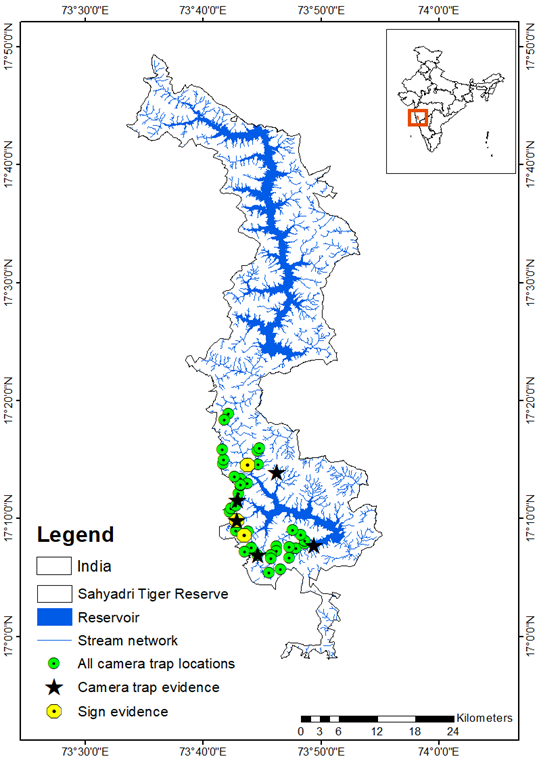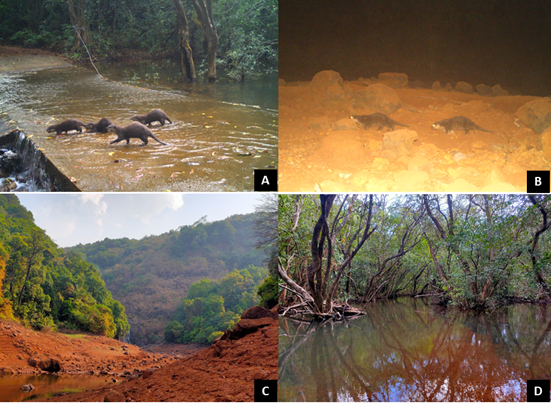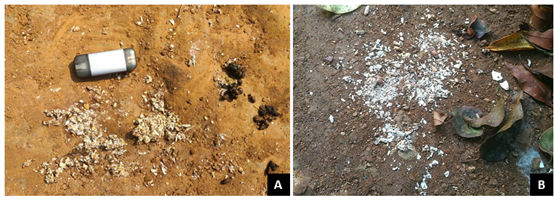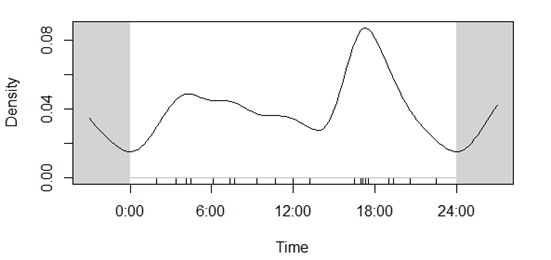IUCN/SSC Otter Specialist Group Bulletin

©IUCN/SCC Otter Specialist Group
Volume 41 Issue 1 (March 2024)
Citation: Sharma, S., Sawant, U., Jelil, S.N., Patil, A., Srivastava, A., and Krishnamurthy, R. (2024). First Breeding Record of Asian Small-Clawed Otter Aonyx cinereus (Illiger, 1815) from Sahyadri Tiger Reserve, Western Ghats, India. IUCN Otter Spec. Group Bull. 41 (1): 15 - 23
First Breeding Record of Asian Small-Clawed Otter Aonyx cinereus (Illiger, 1815) from Sahyadri Tiger Reserve, Western Ghats, India
Shantanu Sharma1, Uttam Sawant2, Shah Nawaz Jelil1, Akash Patil1, Abhilasha Srivastava1, and Ramesh Krishnamurthy1*
1Wildlife Institute of India, Chandrabani, Dehradun, 248001, Uttarakhand, India
1Sahyadri Tiger Reserve, Van Vardhan building, Tarabai Chowk, Kolhapur,
416003, Maharashtra, India
*Corresponding Author Email: ramesh@wii.gov.in
Received 29th April 2023, accepted 21st August 2023
Abstract: Sahyadri Tiger Reserve is a very understudied complex of the Western Ghats landscape of India. The presence of diverse and heterogenous habitats supports a diverse species assembly. Here, we report on the occurrence and breeding of Asian Small-clawed Otters in the tiger reserve through opportunistic camera trapping conducted from November 2021–March 2022 at sampled locations along streams. Asian Small-clawed Otters were recorded from five locations with a photographic capture rate of 0.94 (± 0.57 SE) and in group sizes of 1–5 individuals, including pups. However, extensive surveys are necessary to generate reliable abundance estimates and to clearly understand otter distribution patterns in this landscape..
Keywords: Camera traps, Northern Western Ghats, Mustelidae, Carnivore, Sahyadri Tiger Reserve
INTRODUCTION
India is the westernmost range of the Asian Small-clawed Otter worldwide (Wright et al., 2021). This species is distributed across northeast India, the Himalayan foothills, Eastern Ghats, and Western Ghats (Hussain, 1999; Sharma et al., 2014). The Asian Small-clawed Otter occurs in freshwater and peat swamp forests, rice fields, lakes, streams, reservoirs, canals, mangroves, and along coasts (Hussain et al., 2011). In the Western Ghats, the species prefers high-altitude areas with stream pools (Perinchery et al., 2011), which was found to be contradictory by Punjabi et al. (2014) as they recorded the species’ presence across an elevation gradient of 43–821 m. The species occupies narrow, fast-flowing, and rocky streams, with dense vegetation and tall grasses on both sides of the bank to provide adequate escape cover (Raha and Hussain 2016). The species is sympatric with the Smooth-coated and Eurasian otter. In India, all three species occur in the Western Ghats, Eastern coast and in northeast India (Menon, 2014; Debata et al., 2020; Wright et al., 2021).
Although there is a paucity of robust abundance estimates and population trends, it is suspected that the global population of the Asian Small-clawed Otter has declined by >30% over the past 30 years (Pacifici et al., 2013; Wright et al., 2021). It is further suspected that the future decline can be at least 30% over the next 30 years. The species is classified as Vulnerable by the IUCN Red List of Threatened Species (Wright et al., 2021) and is listed in Appendix II of CITES. It is listed in Schedule I of the Indian Wild Life (Protection) Act, 1972 (amended to date) (WPA, 2022).
The available information on the species ecology primarily comes from the southern Western Ghats. Although the river ecosystems of the northern Western Ghats have been poorly studied, certain remote stream habitats still harbor some of the rare and elusive species, such as otters. Earlier researchers remarked on the lack of species-specific surveys and an overall ecological understanding of otter species (Punjabi et al., 2014). Here, we report the first robust evidence of the occurrence and breeding of the Asian Small-clawed Otter in Sahyadri Tiger Reserve, the northern Western Ghats in Maharashtra state, India.
STUDY AREA
Sahyadri Tiger Reserve (STR), located in the northern Western Ghats of India, spans over an area of 1166 km2, jointly comprised of Chandoli National Park and Koyna Wildlife Sanctuary. The reserve has a rugged terrain with an altitudinal gradient of 350–1250 m. The tiger reserve consists of two major reservoirs: Shivsagar and Vasant Sagar. Undulating topography births numerous torrential streams from the headwater regions feeding into these reservoirs. A previous study reported high fish diversity in its stream and reservoirs. A total of fifty species of fish were recorded from the STR, of which significant species were insectivorous, omnivorous, and herbivorous in their diet preference (Johnson et al., 2019). The STR experiences a mean annual rainfall of 5000 mm from June to September (Joglekar et al., 2015). The tiger reserve represents a heterogeneous landscape covering dense forest, open forest, scrubland, barren land, agricultural land, water body, and reservoir bed (Jelil et al., 2020). The tiger reserve supports some of the few remaining undisturbed tall evergreen forests in the northern Western Ghats. It hosts large mammal species such as the common leopard Panthera pardus fusca, dhole Cuon alpinus, sloth bear Melursus ursinus, Indian gaur Bos gaurus, and sambar Rusa unicolor (Joglekar et al., 2015; Jelil et al., 2021).
MATERIALS AND METHODS
Thirty-eight camera traps were deployed at trails along streams in Chandoli National Park, the southern part of Sahyadri Tiger Reserve, from November 2021–April 2022 (Fig. 1). We used single-sided Cuddeback (C1 model) cameras on suitable trees at 45–50 cm height. Cameras were active 24 hours daily and set on FAP (fast as possible) mode when triggered. These cameras were monitored weekly to ensure proper functioning and data backup. The mean camera trap nights were 55.04 (± 1.09 SE).
Additionally, opportunistic sign surveys were conducted at trails along streams (Fig. 1). The Asian Small-clawed Otter signs were identified and confirmed based on Prater (1971) and Hussain et al. (2011) descriptions.

Images were considered independent when they were at least 30 minutes apart (Rovero and Zimmerman, 2016; Allen et al., 2018, 2020). We calculated the photographic capture rate by dividing the number of independent captures by the total number of camera trap nights (effort) and expressed it per 100 trap nights (Carbone et al., 2001) for each site. We then ran 999 bootstrap samples of the capture rate to estimate mean capture rates and bootstrapped standard error (SE) using the mosaic package (Prium et al., 2017).
We used the activity package (Rowcliffe, 2022) in R to analyze and visualize the temporal activity pattern of the Asian Small-clawed Otter.
RESULTS AND DISCUSSION
Twenty independent photo-captures of the Asian Small-clawed Otter were recorded from five locations in Chandoli National Park (the southern part of the tiger reserve), viz. Karde backwater, Siddheshwar stream, Ramnadi stream, Gothane stream, and stream near Vetti kuti at an elevation range of 624 m to 911 m above sea level (Table 1; Fig 1,2) with a photographic capture rate of 0.94 (± 0.57 SE). The Asian Small-clawed Otters were recorded in groups of 1–5 individuals, including pups. In addition, three other locations, viz. Ram nadi, Kandhar waterfall, and stream near Chandel kuti were confirmed with otter presence through sign surveys (spraints) (Fig. 3). We found the peak activity of the Asian Small-clawed Otter in the evening at around 1800 hours (Fig. 4).
| Table 1: Details of camera trap images of the Asian small-clawed otter in Sahyadri Tiger Reserve | ||||
| Date | Time (hh:mm) | Range | Site ID* | |
| 03-Nov-21 | 19:02 | Chandoli | 01 | |
| 08-Nov-21 | 17:21 | Chandoli | 01 | |
| 08-Nov-21 | 19:23 | Chandoli | 01 | |
| 10-Nov-21 | 4:28 | Chandoli | 01 | |
| 11-Nov-21 | 1:55 | Chandoli | 01 | |
| 14-Nov-21 | 19:58 | Chandoli | 02 | |
| 15-Nov-21 | 7:21 | Chandoli | 01 | |
| 15-Nov-21 | 17:32 | Chandoli | 01 | |
| 18-Nov-21 | 20:36 | Chandoli | 01 | |
| 20-Nov-21 | 9:21 | Chandoli | 01 | |
| 22-Nov-21 | 16:28 | Chandoli | 01 | |
| 23-Nov-21 | 16:31 | Chandoli | 01 | |
| 25-Nov-21 | 7:40 | Chandoli | 01 | |
| 27-Nov-21 | 11:58 | Chandoli | 01 | |
| 01-Dec-21 | 6:06 | Chandoli | 01 | |
| 03-Dec-21 | 22:30 | Chandoli | 01 | |
| 12-Dec-21 | 4:06 | Chandoli | 03 | |
| 15-Feb-22 | 00:31 | Helwak | 04 | |
| 22-Mar-22 | 3:23 | Chandoli | 05 | |
| 26-Mar-22 | 17:05 | Chandoli | 05 | |
| *Site ID: Gothane stream (ID-01), Stream near Vetti kuti (ID-02), Ram nadi stream (ID-03), Siddheshwar stream (ID-04), Karde Backwater (ID-05) | ||||

As pups were photo-captured, these images represent the first confirmed breeding record of the Asian Small-clawed Otters in the tiger reserve. However, incidental photo-captures of otters had been recorded previously from the tiger reserve (pers. obs. SNJ). This finding strengthens the species profile of the tiger reserve. This paper is a significant contribution to filling some of these knowledge gaps about the distribution of Asian Small-clawed Otter in the Sahyadri. Previously, the Asian Small-clawed Otters was first documented from the northern Western Ghats landscape and Maharashtra by Punjabi et al. (2014).

The importance of riparian forests in the lives of semi-aquatic mammal species such as otters is reiterated. These forest and stream habitats provide otters with the necessary cover and food resources and are vital constituents of the terrestrial-aquatic continuum. The presence of Chandoli and Koyna reservoirs makes riparian forests a dominant forest type in the tiger reserve. Jelil et al. (2021) recorded 19 terrestrial mammals along the riparian forests of Koyna Wildlife Sanctuary, the northern part of Sahyadri. They further found that ungulates had the highest occupancy in these riparian forests. This breeding record of the Asian Small-clawed Otter proves an obligate riparian species' presence and growing population in reserve.
Finally, this finding further demonstrates the advantages of using camera traps in wildlife studies. Camera traps in the tiger reserve have been deployed as part of regular monitoring activities and are majorly aimed at large carnivores such as tigers and leopards. However, camera traps provide data on target species and substantial data on non-target species (Edwards et al., 2018; Mazzamuto et al., 2019). Incorporating such by-catch data provides additional insights into a particular area’s overall species inventory and species ecology.
Acknowledgements: We thank the Maharashtra State Forest Department, the National Tiger Conservation Authority, and the Wildlife Institute of India for supporting the study. We thank the Sahyadri Tiger Conservation Foundation for the financial and equipment support. We thank Dr Vidyadhar Atkore (Scientist, SACON) for their review comments on the draft manuscript. We acknowledge the assistance of all the forest officials, especially the beat guards, field assistants, and forest watchmen.
REFERENCES
Allen, M.L., Peterson, B., Krofel, M. (2018). No respect for apex carnivores: distribution and activity patterns of honey badgers in the Serengeti. Mammalian Biology, 89: 90–94. https://doi.org/10.1016/j.mambio.2018.01.001Allen, M.L., Sibarani, M.C., Utoya, L., Krofel, M. (2020). Terrestrial mammal community richness and temporal overlap between tigers and other carnivores in Bukit Barisan Selatan National Park, Sumatra. Animal Biodiversity and Conservation, 43: 97–107. https://doi.org/10.32800/abc.2020.43.0097
Carbone, C., Christie, S., Conforti, K., Coulson, T., Franklin, N., Ginsberg, J.R., Griffiths, M., Holden, J., Kawanishi, K., Kinnaird, M., Laidlaw, R., Lynam, A., Macdonald, D.W., Martyr, D., McDougal, C., Nath, L., O’Brien, T., Seidensticker, J., Smith, D.J.L., Sunquist, M., Tilson, R., Shahruddin, W.N.W. (2001). The use of photographic rates to estimate densities of tigers and other cryptic mammals. Animal Conservation, 4: 75–79. https://doi.org/10.1017/S1367943001001081
Debata, S., Palei, H.S. (2020). An updated checklist of mammals of Odisha, India.Journal of Threatened Taxa, 12(10): 16219-16229. https://doi.org/10.11609/jott.6025.12.10.16219-16229
Edwards, S., Cooper, S., Uiseb, K., Hayward, M., Watcher, B., Melzheimer, J. (2018). Making the most of by-catch data: Assessing the feasibility of using non-target camera trap data for occupancy modelling of a large felid. African Journal of Ecology, 56(4): 885–894. https://doi.org/10.1111/aje.12511
Hussain, S.A. (1999). Status of otter conservation in India. Pages 92-97 in Environmental Information System Bulletin: Wildlife and Protected Areas, Volume 2: Mustelids, Viverrids and Herpestids of India. Wildlife Institute of India, Dehradun. https://wiienvis.nic.in/PublicationDetails.aspx?SubLinkId=309&LinkId=627&Year=2001
Hussain, S.A., Gupta, S.K., de Silva, P.K. (2011). Biology and ecology of Asian small-clawed otter Aonyx cinereus (Illiger, 1815): a review.IUCN Otter Specialist Group Bulletin,28(2): 63-75. https://www.iucnosgbull.org/Volume28/Hussain_et_al_2011.html
Jelil, S.N., Gaykar, A., Girkar, N., Ben, C., Hayward, M. W., Krishnamurthy, R. (2021). Mammal persistence along riparian forests in western India a hydropower reservoir 55 years post construction. Frontiers in Ecology and Evolution, 9: 643285 https://doi.org/10.3389/fevo.2021.643285
Jelil, S.N., Gaykar, A., Girkar, N., Vyas, V., Ben, V.C., Ramesh, K. (2020). Recent record of tiger from Sahyadri Tiger Reserve, India. Cat News, 71: 16–17 http://www.catsg.org/index.php?id=714
Joglekar, A., Tadwalkar, M., Mhaskar, M., Chavan, B., Ganeshaiah, K.N., Patwardhan, A. (2015). Tree species composition in Koyna Wildlife Sanctuary, Northern Western Ghats. Current Science, 108(9): 1688–1693. https://www.currentscience.ac.in/Volumes/108/09/1688.pdf
Johnson, J.A., Rokade, A., Atkore, V., Sivakumar, K., Ben, V.C. (2019). Fishes of Sahyadri Tiger Reserve, Maharashtra: Field Guide. Wildlife Institute of India, Dehradun, Technical Report, TR No/2019/01-78. ISBN: 81-85496-44-7 https://www.researchgate.net/publication/335725100_Fishes_of_Sahyadri_Tiger_Reserve_Maharashtra_Field_Guide/link/5d77d1e24585151ee4adb293/download
Mazzamuto, M.V., Lo Valvo, M., Stefano, A. (2019). The value of by-catch data: how species-specific surveys can serve non-target species. European Journal of Wildlife Research, 65: 68 https://doi.org/10.1007/s10344-019-1310-6
Menon, V. (2014) Indian Mammals: A Field Guide. Hachette Book Publishing India Pvt. Ltd., Gurgaon, India. 528 pp. ISBN 9350097605, 9789350097601
Ministry of Law and Justice (2022). The Wildlife (Protection) Amendment Act (2022). Ministry of Environment and Forests, Government of India, New Delhi. https://pib.gov.in/PressReleasePage.aspx?PRID=1923681
Pacifici, M., Santini, L., Di Marco, M., Baisero, D., Francucci, L., Grottolo Marasini, G., Visconti, P., Rondinini, C. (2013). Generation length for mammals. Nature Conservation 5: 87–94. https://doi.org/10.3897/natureconservation.5.5734
Perinchery, A., Jathanna, D., Kumar, A.J. (2011). Factors determining occupancy and habitat use by Asian small-clawed otters in the Western Ghats, India. Journal of Mammalogy. 92(4): 796–802. https://doi.org/10.1644/10-MAMM-A-323.1
Prater, S.H. (1971). The book of Indian animals. Bombay Natural History Society, Bombay, India. ISBN: 9780195621693
Prium, R., Kaplan, D.T., Horton, N.J. (2017). The mosaic package: Helping students to “Think with Data” using R. The R Journal. 9(1): 77–102. https://journal.r-project.org/archive/2017/RJ-2017-024/index.html
Punjabi, G.A., Borker, A.S., Mhetar, F., Joshi, D., Kulkarni, R., Alave, S.K., Rao, M.K. (2014). Recent records of Stripe-necked Mongoose Herpestes vitticollis and Asian Small-clawed Otter Aonyx cinereus from the northwestern Ghats, India. Small Carnivore Conservation, 51: 51–55. https://www.academia.edu/10806954/Punjabi_G_A_Borker_A_S_Mhetar_F_Joshi_D_Kulkarni_R_Alave_S_K_and_Rao_M_K_2014_Recent_records_of_Stripe_necked_mongoose_Herpestes_vitticollis_and_Asian_small_clawed_otter_Aonyx_cinereus_from_the_north_Western_Ghats_India
R Core team (2020). R: A Language and Environment for Statistical Computing. Vienna: R Foundation for Statistical Computing. https://www.r-project.org/
Raha, A., Hussain, S.A. (2016). Factors affecting habitat selection by three sympatric otter species in the southern Western Ghats, India. Acta Eologica Sinica. 36 (1): 45–49. https://doi.org/10.1016/j.chnaes.2015.12.002
Rovero, F., Zimmerman, F. (2016). Camera trapping for wildlife research. Pelagic Publishing, United Kingdom. ISBN 9781784270483 https://pelagicpublishing.com/products/camera-trapping-for-wildlife-research
Rowcliffe, M. (2022). activity: Animal Activity Statistics. R package version 1.3.2. https://CRAN.R-project.org/package=activity
Sharma, U., Shukla, S., Sinha, P., Purohit, R., Majumdar, A., Rai, A. (2014). Occurrence of Asian small-clawed otter Aonyx cinereus (Illiger, 1815) in Eastern India.Current Science,107(3): 367. https://www.currentscience.ac.in/Volumes/107/03/0367.pdf
Wickham, H. (2016). ggplot2: Elegant Graphics for Data Analysis. New York, NY: Springer-Verlag. https://doi.org/10.1007/978-3-319-24277-4
Wright, L., de Silva, P.K., Chan, B., Reza Lubis, I. & Basak, S. (2021). Aonyx cinereus. The IUCN Red List of Threatened Species 2021: e.T44166A164580923. https://dx.doi.org/10.2305/IUCN.UK.2021-3.RLTS.T44166A164580923.en
Résumé: Premiere Synthese sur la Reproduction de Loutre Cendrée Aonyx cinereus (Illiger, 1815) dans la Réserve des Tigres De Sahyadri, aux Ghats Occidentaux, en Inde
La loutre cendrée, Aonyx cinereus, est l’objet d’un commerce international en vue de répondre à la demande d’animaux de compagnie, à la fois légalement et illégalement. En 2019, l'espèce est passée de l’Annexe II de la Convention sur le commerce international des espèces de faune et de flore sauvages menacées d’extinction (CITES) à l’Annexe I, qui interdit généralement le commerce international, car son commerce est considéré comme une menace pour la conservation de l’espèce. Bien que la législation nationale japonaise protège strictement les espèces inscrites à l’Annexe I de la CITES, il est toujours possible de commercialiser la loutre cendrée au niveau national, sous réserve de procédures d’enregistrement nécessaires. Nous examinons ici les niveaux actuels du commerce des loutres cendrées au Japon et l’impact de leur inscription aux annexes de la CITES.
Revenez au dessus
Resumen: Primer Registro de Reproducción de Nutria de Uñas Pequeñas Asiática Aonyx cinereus (Illiger, 1815) de la Reserva de Tigres Sahyadri, Ghats Occidentales, India
La réserve des Tigres de Sahyadri est un complexe très peu étudié du paysage des Ghâts occidentaux de l’Inde. La présence d’habitats divers et hétérogènes favorise un regroupement d’espèces diversifiées. Nous relatons ici la présence et la reproduction de loutres cendrées dans la réserve des Tigres à l’aide de pièges photographiques adaptés entre novembre 2021 et mars 2022 sur des sites sélectionnés le long des cours d’eau. Des loutres cendrées ont été observées sur cinq sites avec un taux de capture photographique de 0,94 (± 0,57 SE) et des groupes de 1 à 5 individus, y compris les loutrons. Cependant, des études approfondies sont nécessaires pour générer des estimations fiables de l’abondance et pour comprendre clairement les schémas de répartition des loutres dans ce paysage
Vuelva a la tapa
सार : सह्याद्रि टाइगर रिज़र्व भारत के पश्चिमी घाट का काफी कम अध्ययन किया गया परिक्षेत्र है। विविध और विषम आवासों की उपस्थिति विविध प्रजातियों के संयोजन का समर्थन करती है। हमने इस टाइगर रिजर्व में नवंबर 2021 से मार्च 2022 तक कुछ नदी के किनारे के स्थानों पर कैमरा ट्रैपिंग की तथा हमने एशियाई छोटे पंजो वाले ऊदबिलाव की उपस्थिति तथा प्रजनन का वर्णन किया। एशियाई छोटे पंजे वाले ऊदबिलाव को हमने पांच जगहों पर 0.94 (± 0.57) फोटोग्राफिक कैप्चर रेट एवं 1 - 5 के समूह में बच्चों के साथ पाया। हालांकि, इनकी विश्वसनीय अनुमानित संख्या एवं ऊदबिलावो के इस परिदृश्य में विचरण के स्वरूप का पता लगाने के लिए और अधिक सर्वेक्षण की अति आवश्यकता है।
सारांश: सह्याद्री व्याघ्र प्रकल्प हा भारताच्या पश्चिम घाटाच्या प्रदेशातील अत्यंत कमी अभ्यासलेला भूभाग आहे. या ठिकाणी असलेल्या वैविध्यपूर्ण आणि विषम अधिवासांची उपस्थिती विविध प्रजातींच्या संमेलनास साथ देते. येथे, आम्ही नोव्हेंबर २०२१ ते मार्च २०२२ या कालावधीत जंगलातील प्रवाहाच्या बाजूने प्राथमिक सर्वेक्षण केलेल्या ठिकाणी कॅमेरा ट्रॅपिंगद्वारे व्याघ्र प्रकल्पात (Asian Small-clawed Otters) आशियाई लहान-नखे असलेल्या औटर्सच्या प्रजातीची उपस्थिती आणि प्रजननाचे पुरावे नोंद केले आहेत. ०.९४ (± ०.५७ SE) च्या फोटोग्राफिक कॅप्चर रेटसह आणि १-५ पिल्लांसह पाच ठिकाणांहून एशियन स्मॉल-क्लॉड ऑटर्स चा रेकॉर्ड केले गेले आहेत. तसेच,या प्रजातीच्या विपुलतेचे विश्वसनीय अंदाज तयार करण्यासाठी आणि या प्रदेशात ओटर्सचे वितरण नमुने स्पष्टपणे समजून घेण्यासाठी विस्तृत सर्वेक्षणेची आवश्यकता आहे.
आरंभ पर लौटें






